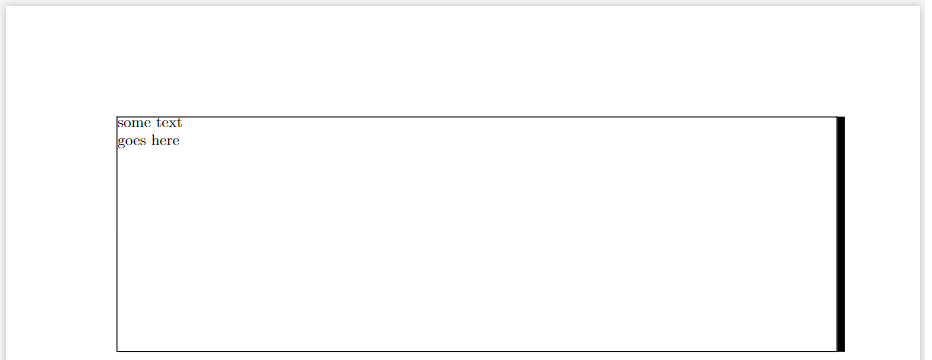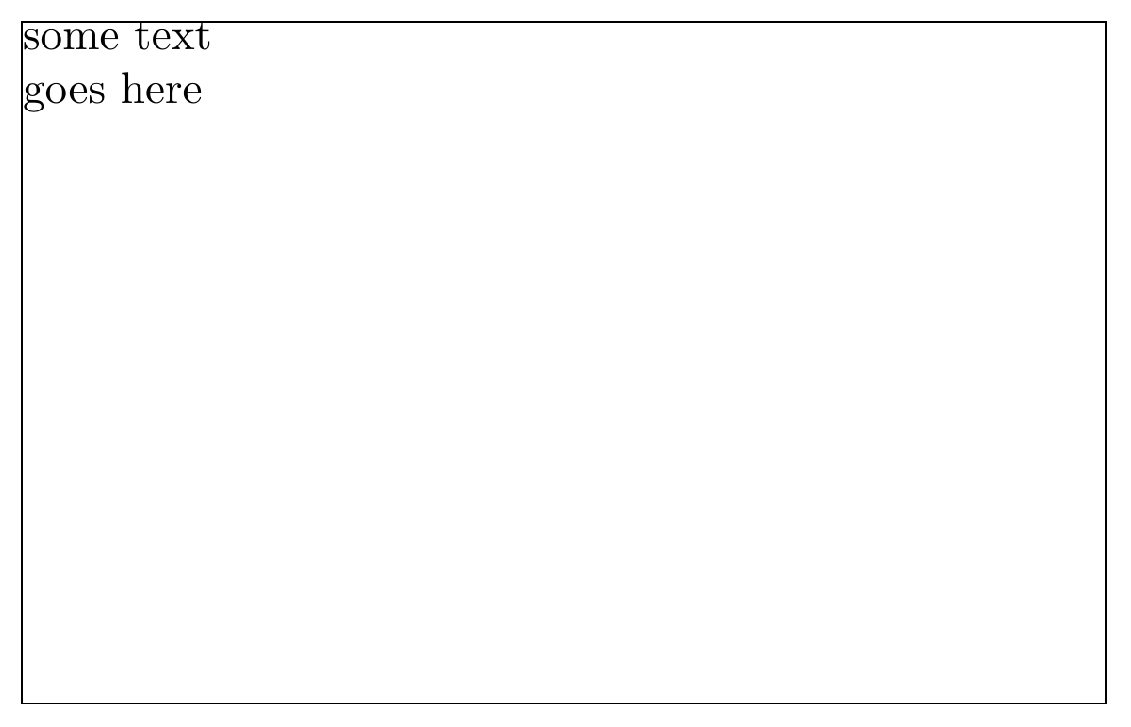UdiB

I want to typeset a framebox with plainTeX. The box should be 3.375in wide × 2.125in high, and I want 4 rules to mark its border (with `hrule` and `vrule`).
I tried by I get a box which is as wide at the textwidth of the document and an `overfull hbox` warning. Why?
```
% !TEX TS-program = luatex
\synctex=0
\newdimen\cardwidth \cardwidth3.375in
\newdimen\cardheight \cardheight2.125in
\hbox to\cardwidth{\parindent0pt%
\vrule \vbox to \cardheight{\hrule%
some text\par goes here\vfil\hrule%
}%
\vrule
}
\bye
```

Top Answer
frougon

The problem is that the width of your `\vbox` is determined by the `\hsize` parameter, whose value comes from the default set in plain.tex (`\hsize=6.5in`). Set `\hsize` inside the `\vbox` so that it accounts for the width of the two vertical rules and you're done.
In addition to this:
- I moved the `\parindent` assignment where it is really needed;
- I intentionally left a space token after every physical unit keyword (`in`, `pt`, etc.) occuring in TeX assignments (see the note below);
- I replaced `\hbox to \cardwidth` with `\hbox` because the width of this `\hbox` is already determined by its contents (it does work with `\hbox to \cardwidth`; simply, that would be “overconstrained”).
You can check the precise box measures by uncommenting the line containing `\tracingoutput=1 \tracingonline=1` (the lengths are given in `pt`; your `\cardwidth` and `\cardheight` include the rule widths).

```
\newdimen\cardwidth
\newdimen\cardheight
\cardheight 2.125in
\cardwidth 3.375in
% May be helpful: \tracingoutput=1 \tracingonline=1
\hbox{%
\vrule
\vbox to \cardheight {%
\hsize=\dimexpr \cardwidth - 0.4pt*2\relax
\parindent=0pt
\hrule
some text\par
goes here\vfil
\hrule
}%
\vrule
}
\bye
```
# Note
The idea behind the space token I leave after every physical unit keyword occuring in a TeX assignment, besides improving readability, is to prevent, for instance, `\foo = 3in\bar` resulting in a breakage should the beginning of the expansion of `\bar` ever expand to x and `inx` be an existing physical unit keyword in some hypothetical future release of TeX (!). The grammar displayed on TeXbook p. 270 has been tailored for this: it shows that TeX always reads ⟨one optional space⟩ after a ⟨physical unit⟩ in the production rules for ⟨unit of measure⟩.
# Another note (on `\topskip` and glue setting in boxes)
Using `\tracingoutput=1 \tracingonline=1`, you can see that `\topskip` is set to `0pt` according to TeXbook pp. 113-114:
```
.\vbox(643.20255+0.0)x243.91124, glue set 489.6288fill
..\glue(\topskip) 0.0
..\hbox(153.57375+0.0)x243.91124
...\rule(*+*)x0.4
...\vbox(153.57375+0.0)x243.11125, glue set 132.67853fil []
...\rule(*+*)x0.4
..\glue 0.0 plus 1.0fill
```
This is fine and expected, because your `\hbox` is the first box in the page body and its height is `153.57375pt`, which is more than `10pt` (plain.tex sets `\topskip=10pt`).
The only glue item that stretches in the tall `\vbox` that corresponds to the page body:
```
\vbox(643.20255+0.0)x243.91124, glue set 489.6288fill
```
is its final item, namely `\glue 0.0 plus 1.0fill` (it comes from `\bye`, defined with `\outer\def\bye{\par\vfill\supereject\end}`). The stretching is performed on the highest-order component that doesn't “cancel out” considering all glue items in the box, i.e. `fill` here (cf. TeXbook p. 77). The glue setting corresponding to the above `glue set 489.6288fill` diagnostic message does provide the needed amount of space in the vertical direction:
489.6288 × 1.0 = 489.6288 = 643.20255 - 153.57375.
I'm so relieved! :)